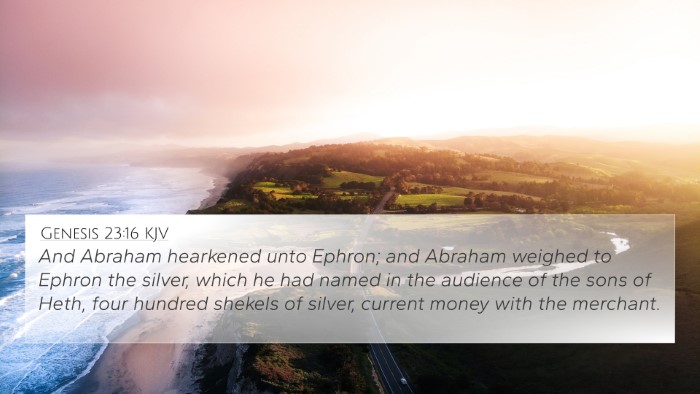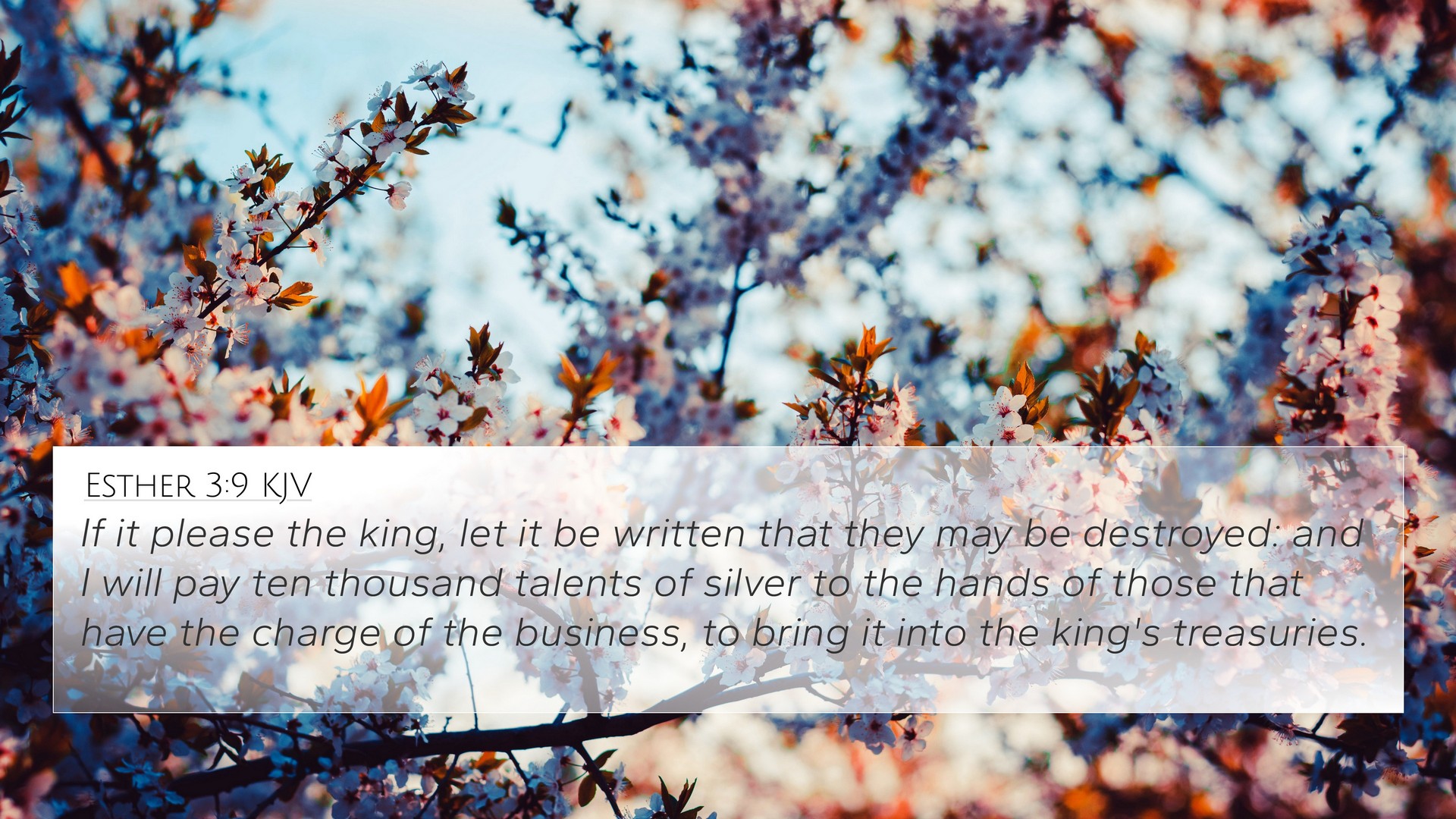Old Testament
Genesis Exodus Leviticus Numbers Deuteronomy Joshua Judges Ruth 1 Samuel 2 Samuel 1 Kings 2 Kings 1 Chronicles 2 Chronicles Ezra Nehemiah Esther Job Psalms Proverbs Ecclesiastes Song of Solomon Isaiah Jeremiah Lamentations Ezekiel Daniel Hosea Joel Amos Obadiah Jonah Micah Nahum Habakkuk Zephaniah Haggai Zechariah MalachiEsther 3:9 Similar Verses
Esther 3:9 Cross References
If it please the king, let it be written that they may be destroyed: and I will pay ten thousand talents of silver to the hands of those that have the charge of the business, to bring it into the king's treasuries.
Uncover the Rich Themes and Topics of This Bible Verse
Listed below are the Bible themes associated with Esther 3:9. We invite you to explore each theme to gain deeper insights into the Scriptures.
Esther 3:9 Cross Reference Verses
This section features a detailed cross-reference designed to enrich your understanding of the Scriptures. Below, you will find carefully selected verses that echo the themes and teachings related to Esther 3:9 KJV. Click on any image to explore detailed analyses of related Bible verses and uncover deeper theological insights.

Genesis 23:16 (KJV) »
And Abraham hearkened unto Ephron; and Abraham weighed to Ephron the silver, which he had named in the audience of the sons of Heth, four hundred shekels of silver, current money with the merchant.

Matthew 18:24 (KJV) »
And when he had begun to reckon, one was brought unto him, which owed him ten thousand talents.
Esther 3:9 Verse Analysis and Similar Verses
Understanding Esther 3:9
Esther 3:9 states:
"If it pleases the king, let it be decreed that they be destroyed; and I will pay ten thousand talents of silver into the hands of those who have charge of the king's business, that they may put it into the king's treasuries."
Summary of the Verse
This verse introduces a plot by Haman, an Agagite and high-ranking official in Persia, to destroy the Jewish people. Haman approaches King Ahasuerus with a proposal to eliminate a group that he perceives as a threat, offering a substantial bribe to fund this evil plan.
Thematic Insights
- Conflict: The verse highlights the tension between Haman and the Jewish people, revealing the dangers faced by those who remain faithful to God.
- Greed: Haman's willingness to bribe the king reflects a deeper theme of corruption and moral compromise in pursuit of power.
- Divine Providence: This plot sets the stage for God's intervention, illustrating the continuing struggle between good and evil throughout biblical history.
Bible Verse Cross-References
To better understand the implications of Esther 3:9, we can refer to a selection of related verses:
- Genesis 12:3: God's promise to bless those who bless His people and curse those who curse them.
- Exodus 17:14: God instructing Moses to record the Amalekites’ deed against Israel, representing enduring enmity.
- Proverbs 22:8: "He who sows injustice will reap calamity," echoing the principles of divine justice.
- Esther 7:10: Haman’s downfall, showcasing the reversal of his fortunes as a result of his actions.
- Psalm 37:1-2: Encouragement not to fret over evildoers, an assurance of God’s justice.
- Daniel 6:3-5: Illustrating jealousy that leads to a conspiracy against a faithful servant of God, paralleling Haman's malice.
- Matthew 5:10-12: Teaching that those who are persecuted for righteousness' sake are blessed.
- Romans 8:31: The assurance that if God is for us, who can be against us?
- Revelation 6:10: The cry of the martyrs for justice, resonating with the plight of the Jews in Esther.
- Galatians 6:7: A reminder that God will not be mocked and that whatever a person sows, that will they also reap.
Comparative Bible Verse Analysis
Examining Esther 3:9 in light of the cross-references provides a broader context:
- God's covenant with Israel: The promise in Genesis 12:3 emphasizes that actions against God’s people provoke divine response, as seen in Haman’s eventual downfall.
- Moral Law and Consequences: Proverbs 22:8 and Galatians 6:7 emphasize the principle of reaping what one sows, reflected in the fateful decisions made by Haman.
- Persecution and Faithfulness: Matthew 5:10-12 serves as an underlying theme of faithfulness in the face of adversity, as the Jewish people remained steadfast despite Haman's threats.
Inter-Biblical Dialogue
The themes in Esther 3:9 invoke discussions on loyalty, integrity, and faith throughout scripture, connecting narratives across both the Old and New Testaments.
Using Bible Cross-References for Deeper Study
Utilizing tools for Bible cross-referencing such as a Bible concordance or cross-reference Bible study guides can enhance understanding. Here are a few methods:
- Identifying connections: Look for thematic links between the Old Testament and New Testament, such as between Esther and the teachings of Jesus.
- Comparative studies: Analyze texts in parallel, noting how similar themes are addressed in different contexts.
- Thematic connections: Explore how the themes of persecution in Esther resonate with passages in the Gospels and epistles.
Conclusion
Esther 3:9 is a pivotal verse that encapsulates the malice directed towards God's chosen people by Haman, foreshadowing the dramatic reversals of fortune that characterize the Book of Esther. By engaging in cross-referencing and analysis, believers can glean wisdom and hope, knowing that the struggles of God's people have always been met with divine justice and providence.


